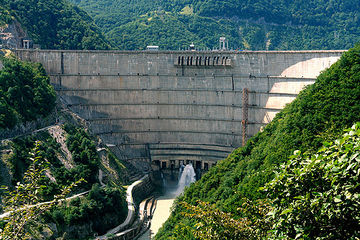Gravitational potential energy
Gravitational potential energy is the energy possessed by masses according to their spatial arrangement and the gravitational force (one of the four fundamental forces) that pulls them towards one another.[2] Since Earth is so large compared to the objects on it, it's easy to watch these objects being pulled (falling) towards the center of the planet, not the planet being pulled towards the object. The direction of Earth's gravitational pull is just called "down."
There's a simulation to play with potential energy that shows the interaction of gravitational potential energy, kinetic energy and spring energy. The simulation below shows how energy flows back and forth between kinetic energy and gravitational potential energy (this is called mechanical energy).
Potential energy due to gravity is calculated using the following formula:[2]
- E is energy, measured in joules (J)
- m is mass, measured in kilograms (kg)
- g is the acceleration due to gravity measured in m/s2. On the surface of Earth this is 9.81 m/s2.
- h is the height of an object relative to where it would be if it fell, measured in metres (m)
- The more mass an object has, the more energy it stores. A 20 kg mass stores twice as much gravitational potential energy as a 10 kg mass at the same height.
- The higher up an object is, the more energy it stores. A mass 10 m above the ground stores twice as much energy as the same mass only 5 m above the ground.
- A stronger gravitational pull will also result in more gravitational potential energy. A mass 8 m above the surface of Earth stores much more gravitational potential energy than it would if it were 8 m above the moon.
Some forms of hydropower indirectly harness gravitational potential energy. The water behind a hydroelectric dam stores gravitational potential energy since it is at a higher level than the water on the other side of the dam. As the water falls, this potential energy is converted into kinetic energy, which turns turbines to generate electricity.
PhET: Energy skate park
The University of Colorado has graciously allowed us to use the following Phet simulation. Explore this simulation to see how gravitational potential energy and kinetic energy go back and forth but keep mechanical energy the same. Notice how mechanical energy can be lost and turned into thermal energy, but the total amount of energy still stays the same:
- ↑ Wikimedia Commons. (August 31, 2015). Ingur Hydroelectric Facility [Online]. Available: https://commons.wikimedia.org/wiki/File:Ingur_Hydroelectric_Power_Station.jpg
- ↑ 2.0 2.1 R. D. Knight, "Work and Kinetic Energy" in Physics for Scientists and Engineers: A Strategic Approach, 3nd ed. San Francisco, U.S.A.: Pearson Addison-Wesley, 2008, ch.11, sec.5, pp.313-315


